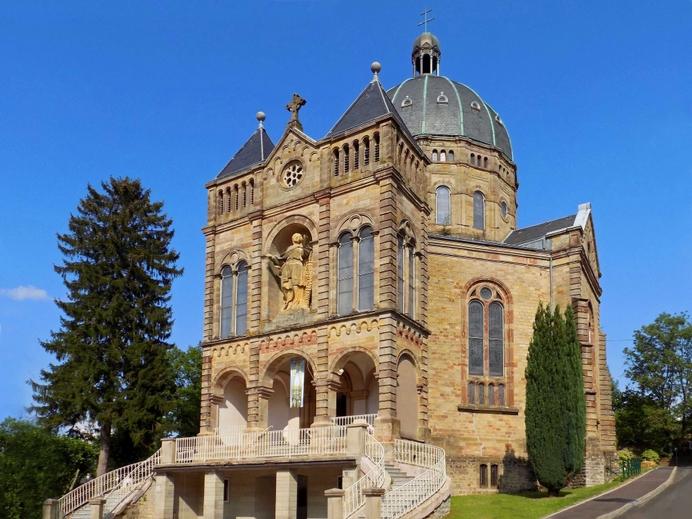
Basilica of Notre Dame de Bon Secours in St. Avold.
A living Tradition in the Process of Christianisation
As in previous years, the Canisianum of the Priestly Fraternity of Saint Peter (German District) in Saarlouis (Saarland, Germany) organised a French-German pilgrimage to Notre-Dame-de-Bon-Secours in Saint-Avold (France) on Saturday 7 October 2023. This annual pilgrimage, organised by the FSSP, encourages pilgrims from France, Germany and the whole of the Benelux countries to discover the Catholic origins of the region through this tradition.
A precious Patrimony
The pilgrimage to Our Lady of Good Help dates back to the 16th century, when the Benedictine monks of Saint-Avold erected a chapel in honour of the Mother of the Redeemer to prevent the expansion of Protestantism. Pilgrimages to the miraculous image grew until the Revolution, when it was banned. The statue was recovered and hidden by some ladies of the village and reinstalled in the sanctuary in 1806. Even today, souls who trust in Our Lady come from Europe to confide in her and receive many graces through Mary's intercession.
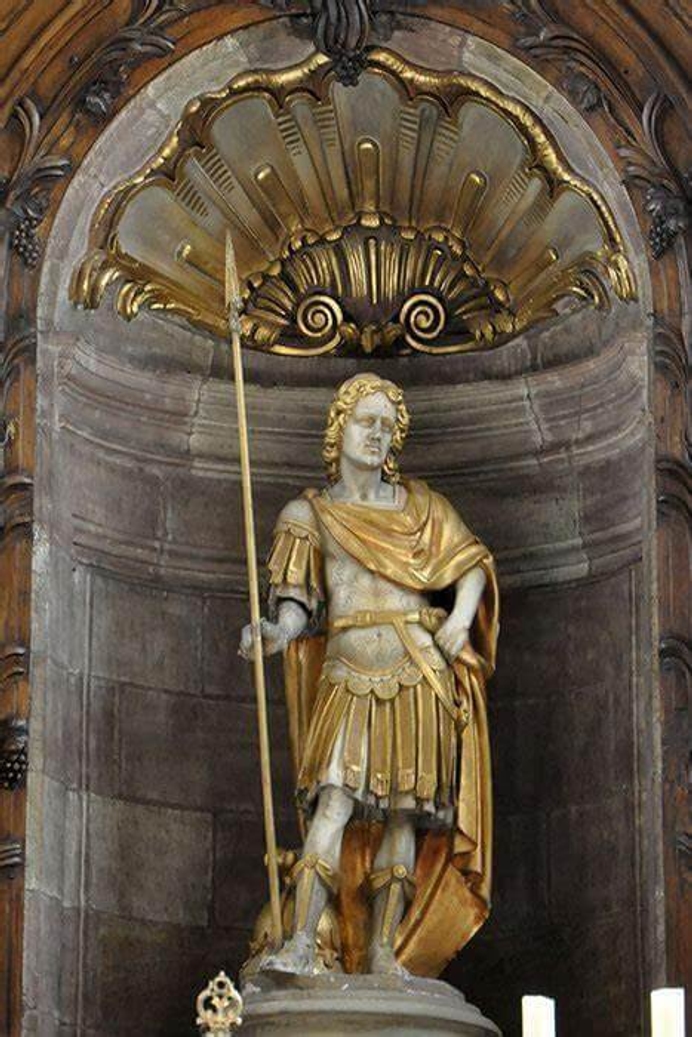
St. Nabor,
Saint Nabor (or Nabord) Martyr (+ c. 303)
Little is known about the life of this saint except that he was a Roman soldier who had faith, a vibrant and active piety. Originally from North Africa, Nabor testified to his faith in Jesus Christ by shedding his blood for Him in 303. The bodies of Victor, Felix and Nabor were soon taken to Milan, where they were received and venerated by St Ambrose, St Augustine and the other Church Fathers of the time.
Saint Chrodegand, a great bishop of Metz, who worked hard to introduce the Roman liturgy in France, received the relics of Saint Nabor from Pope Paul I as a reward for his services. On 25 August 763, he entrusted them to a young monastery that he protected, Cella-Nova. He gave his name to the town that would grow on its outskirts, which until then had been called Hilarium. Gradually, the town and the monastery took the name of the Roman soldier, a name that eventually became St-Avold due to linguistic progress. The parish church, however, kept the name of the martyr. Every year, on the Sunday following the 24th of August, the parish commemorates its patron saint, whose relics it cherishes, in memory of this unknown soldier who loved Jesus so much that he gave his life as a sign of his love....
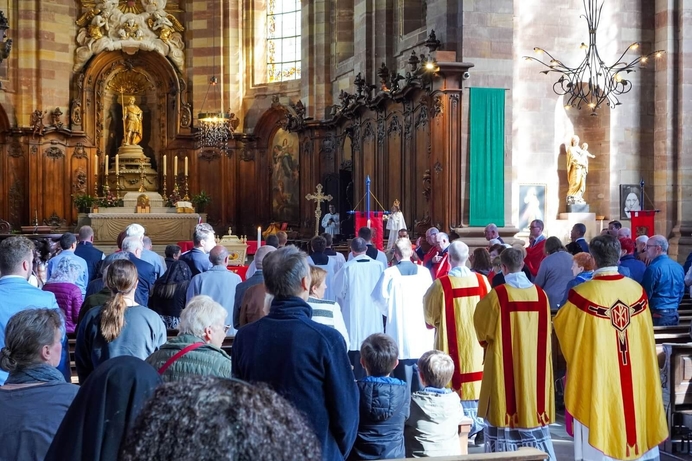
The solemn procession of the Priestly Fraternity of St. Peter of the H. Mass in the St. Nabor abbey church.
Parish of Saint-Avold, Saint-Nabor abbey church
According to tradition, an Irish monk by the name of Fridolin came from Poitiers in 509 and founded an oratory called Hilariacum on the site of Saint-Avold before founding the monastery of Sickingen in Germany. Chrodegang (712-766), Bishop of Metz and minister of Charles Martel and Pepin the Short, introduced the Benedictine Rule of St Benedict. On a trip to Rome, he brought back the relics of Saint Nabor, an officer martyred by Diocletian on 24 August 765, and gave that name to the abbey and the town that was to become it. In the shadow of the monastery, renowned for its scriptorium, the village developed. The monastery was placed under the protection of the bishops of Metz. Angelram, 36th bishop of Metz from 766 to 791, came from this abbey. He remains buried there.

The programme was initiated with a sung high Mass (Tridentine rite) in the abbey church of St Nabor, the unbloody renewal of the Holy Cross, wonderfully enriched with Gregorian chant, French and German hymns and an inspiring homily by the celebrant: Stephen Reiner, Vicar General of the FSSP. The homily, which was given in both French and German, focused on the actual intercession of the Blessed Mother of God, of whom St Louis Maria Grignon de Montfort wrote in his masterpiece, 'The Treatise on True Devotion to the Blessed Virgin, ' " This devotion, when faithfully undertaken, is a perfect means of ensuring that the value of all our good works is being used for the greater glory of God.." (Chapter 5 Argument 4)

Veneration of the Holy Martyr's relics.
Then began the solemn ceremony in which the faithful venerated the relics of the saint who gave his name to the town. The foundation of the city, which was accompanied by the Christianisation of the pagan peoples of the time, still plays an important role in the lives of the residents, who faithfully take part in the celebrations, thus strengthening their true Catholic identity.
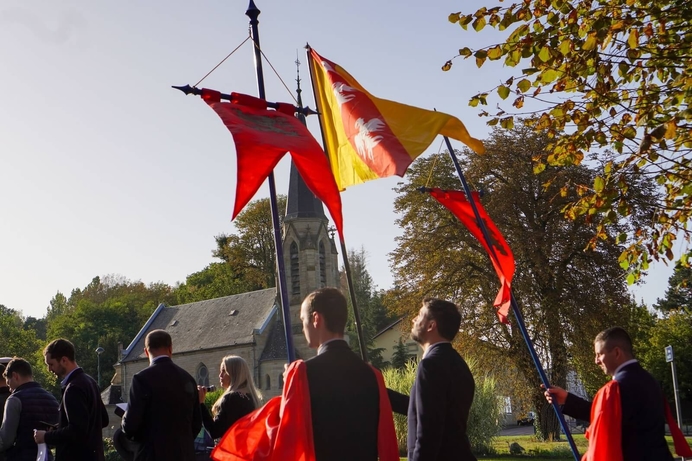
A public act of religion, staying true to their Catholic identity.
Procession led by the Saint-Louis band
On the way to the abbey church, the band provided an ode to the holy martyr who was being celebrated, and from the church they made up the musical centrepiece of the procession through the town to the basilica of Notre-Dame de Bon Secours in Saint-Avold. During the religious event, the rosary was recited, accompanied by local songs and marching music.
Arriving at the basilica, which has undergone several restorations, the delegation of honour entered with a replica of Notre-Dame de Bon Secours, priests from the Fraternity of Saint Peter, the standard bearer of Lorraine and volunteers from the TFP (who took the initiative to revitalise this precious tradition). All the seats in the church were occupied for the solemn adoration of Our Lord in the Blessed Sacrament at the end of the pilgrimage. After the Eucharistic blessing, Marian hymns were sung under the direction of Father Stefan Reiner, in thanksgiving for all the graces we had obtained.
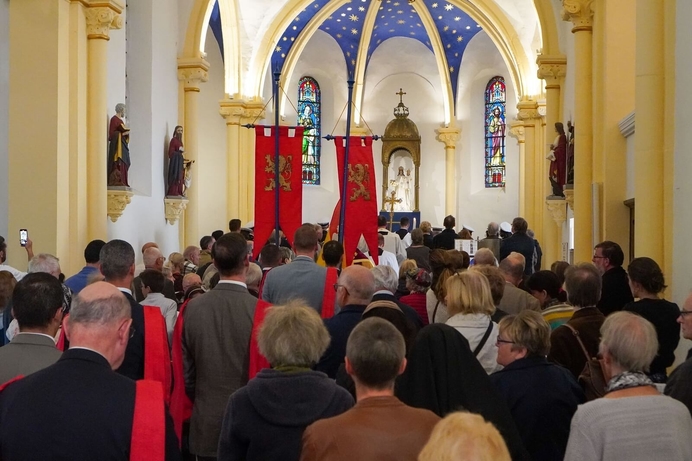
Inside the Sanctuary of Our Lady of Bon-Secours
